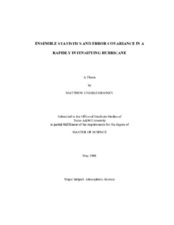| dc.description.abstract | This thesis presents an investigation of ensemble Gaussianity, the effect of non-
Gaussianity on covariance structures, storm-centered data assimilation techniques, and
the relationship between commonly used data assimilation variables and the underlying
dynamics for the case of Hurricane Humberto. Using an Ensemble Kalman Filter
(EnKF), a comparison of data assimilation results in Storm-centered and Eulerian
coordinate systems is made. In addition, the extent of the non-Gaussianity of the model
ensemble is investigated and quantified. The effect of this non-Gaussianity on
covariance structures, which play an integral role in the EnKF data assimilation scheme,
is then explored. Finally, the correlation structures calculated from a Weather Research
Forecast (WRF) ensemble forecast of several state variables are investigated in order to
better understand the dynamics of this rapidly intensifying cyclone.
Hurricane Humberto rapidly intensified in the northwestern Gulf of Mexico from
a tropical disturbance to a strong category one hurricane with 90 mph winds in 24 hours.
Numerical models did not capture the intensification of Humberto well. This could be
due in large part to initial condition error, which can be addressed by data assimilation schemes. Because the EnKF scheme is a linear theory developed on the assumption of
the normality of the ensemble distribution, non-Gaussianity in the ensemble distribution
used could affect the EnKF update. It is shown that multiple state variables do indeed
show significant non-Gaussianity through an inspection of statistical moments.
In addition, storm-centered data assimilation schemes present an alternative to
traditional Eulerian schemes by emphasizing the centrality of the cyclone to the
assimilation window. This allows for an update that is most effective in the vicinity of
the storm center, which is of most concern in mesoscale events such as Humberto.
Finally, the effect of non-Gaussian distributions on covariance structures is
examined through data transformations of normal distributions. Various standard
transformations of two Gaussian distributions are made. Skewness, kurtosis, and
correlation between the two distributions are taken before and after the transformations.
It can be seen that there is a relationship between a change in skewness and kurtosis and
the correlation between the distributions. These effects are then taken into consideration
as the dynamics contributing to the rapid intensification of Humberto are explored
through correlation structures. | en |


